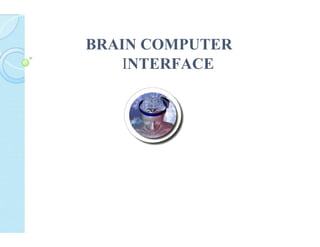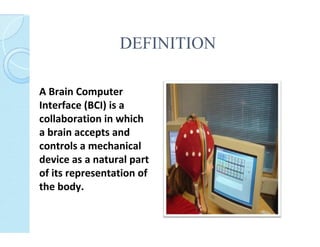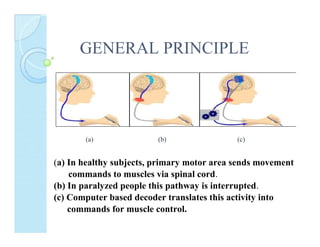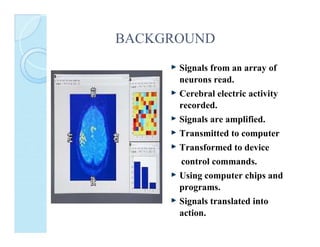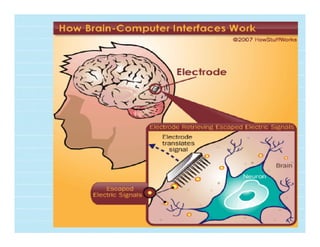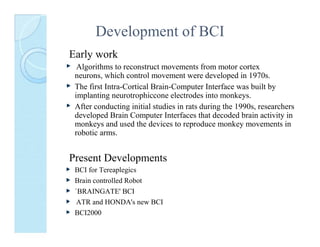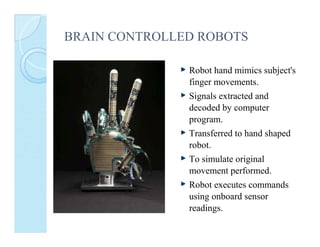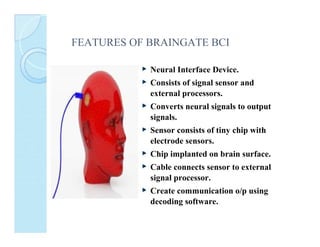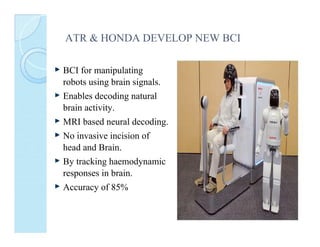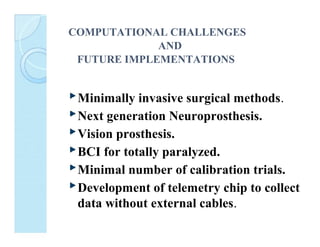Brain computer interface
- 2. DEFINITION A Brain Computer Interface (BCI) is a collaboration in which a brain accepts and controls a mechanical device as a natural part of its representation of the body.
- 3. GENERAL PRINCIPLE (a) (b) (c) (a) In healthy subjects, primary motor area sends movement commands to muscles via spinal cord. (b) In paralyzed people this pathway is interrupted. (c) Computer based decoder translates this activity into commands for muscle control.
- 4. BACKGROUND Signals from an array of neurons read. Cerebral electric activity recorded. Signals are amplified. Transmitted to computer Transformed to device control commands. Using computer chips and programs. Signals translated into action.
- 6. BASIC COMPONENTS The implant device, or chronic multielectrode array The signal recording and processing section An external device A feedback section to the subject
- 7. Development of BCI Early work Algorithms to reconstruct movements from motor cortex neurons, which control movement were developed in 1970s. The first Intra-Cortical Brain-Computer Interface was built by implanting neurotrophiccone electrodes into monkeys. After conducting initial studies in rats during the 1990s, researchers developed Brain Computer Interfaces that decoded brain activity in monkeys and used the devices to reproduce monkey movements in robotic arms. Present Developments BCI for Tereaplegics Brain controlled Robot `BRAINGATE' BCI ATR and HONDA's new BCI BCI2000
- 8. BCI for Tetraplegics 6- channel EEG BCI used. Sensory & motor cortices activated during attempts. Control scheme sends movement intention to Prosthetic Controller. Prosthetic returns force sensory information to Controller. Feedback processed and grip is adjusted.
- 9. BRAIN CONTROLLED ROBOTS Robot hand mimics subject's finger movements. Signals extracted and decoded by computer program. Transferred to hand shaped robot. To simulate original movement performed. Robot executes commands using onboard sensor readings.
- 10. `BRAINGATE' BCI The `Braingate' device can provide motor-impaired patients a mode of communication through the translation of thought into direct computer control.
- 11. FEATURES OF BRAINGATE BCI Neural Interface Device. Consists of signal sensor and external processors. Converts neural signals to output signals. Sensor consists of tiny chip with electrode sensors. Chip implanted on brain surface. Cable connects sensor to external signal processor. Create communication o/p using decoding software.
- 12. ATR & HONDA DEVELOP NEW BCI BCI for manipulating robots using brain signals. Enables decoding natural brain activity. MRI based neural decoding. No invasive incision of head and Brain. By tracking haemodynamic responses in brain. Accuracy of 85%
- 13. BCI APPLICATIONS Medical applications(restoration of a communication channel for patients with lockedin syndrome and the control of neuroprostheses in patients affected by spinal cord injuries ) Military applications Counter terrorism(10 times faster image search) multimedia and virtual reality applications
- 14. DRAWBACKS EEGs measure tiny voltage potentials. The signal is weak and prone to interference. Each neuron is constantly sending and receiving signals through a complex web of connections. There are chemical processes involved as well, which EEGs can't pick up on. The equipment heavy(~10 lbs.) & hence not portable.
- 15. COMPUTATIONAL CHALLENGES AND FUTURE IMPLEMENTATIONS Minimally invasive surgical methods. Next generation Neuroprosthesis. Vision prosthesis. BCI for totally paralyzed. Minimal number of calibration trials. Development of telemetry chip to collect data without external cables.
- 16. CONCLUSION A potential therapeutic tool. BCI System is nominated for European ICT Grand Prize. the Potentially high impact technology.
- 17. Thank you

